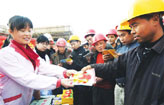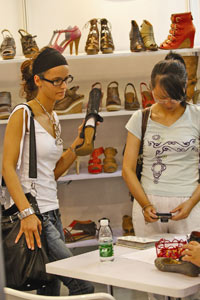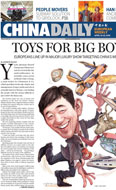Economy
Shoe exporters seize renewed trading opportunities
Updated: 2011-04-18 08:00
By Tang Zhihao (China Daily)
BEIJING - Despite an expected jump in the number of leather shoes
|
A business woman from Europe examines shoe samples and prices at a trade fair in Dongguan, in South China's Guangdong province. Shan Jun / For China Daily |
Exports of leather shoes to Europe declined sharply after the European Union imposed a four-year anti-dumping duty on made-in-China shoes in 2006. According to the China Leather Industry Association (CLIA), the volume declined from 197 million pairs in 2005 to 144 million pairs in 2009.
Wenzhou, one of the largest shoes manufacturing bases, which accounts for more than 11 percent of annual shoe production in China, reported a 39 percent decline in orders from Europe between 2006 and 2009.
In the past few months, Chinese footwear manufacturers have received a large number of orders and queries from European customers after the European Union announced it was lifting the anti-dumping duty on Chinese leather shoes. An export rebound is being predicted.
"The annual growth rate may not go beyond 50 percent in 2011. However, a 20 to 30 percent annual growth increase will not surprise me a lot," said Wei Yafei, a director with the shoes sector of CLIA. "I hope exports can resume to the same levels as in 2005 over the next few years".
Wang Hailong, the public relations manager of Zhejiang Aokang Shoes Co, said orders from GEOX, one of Aokang's largest trading partners in Europe, increased by about 60 percent in the first quarter of 2011.
"The annual export volume to the European market is expected to reach 3 million pairs, up from 2 million pairs in 2010," said Wang.
Although Chinese shoe makers are keeping a close eye on the European market, industry insiders said Chinese companies need to maintain stable exports over the next few months to avoid unnecessary trade friction.
According to the Ministry of Commerce of China, European policy makers have decided to implement a monitoring regime to oversee the volume of shoes imported from China. The measure will be effective for one year from April 1. Further action might be taken if there is evidence to suggest Chinese shoe exports will hurt local industry.
"European regulators may be worried that a steep rise in shoe imports may hurt local shoe manufacturing companies so maintaining a stable export volume will benefit Chinese companies in the long run," said Wei from CLIA.
"Although the anti-dumping duty was lifted, Chinese companies still need to be cautious in preparing orders from overseas. For instance, companies need to prepare certificates of origin and pay more attention to intellectual property rights protection," added Wei.
The introduction of the anti-dumping duty of up to 16.5 percent on Chinese shoes has seriously affected the development of Chinese companies in the European market and led to unemployment in the footwear industry.
It was reported by Southern Metropolis Daily that some 20,000 shoe manufacturing workers lost their jobs between 2006 and 2008.
Aokang and some other Chinese companies were forced to take legal action in Europe in 2007 to protect their interests in the European market.
"China's market economy status is not recognized in Europe, so investigators from Europe adopted reference figures from third countries to evaluate our costs of production. It is unfair because those figures cannot truly reflect the real situation in China's footwear industry," said Wang from Aokang. "We still can make little profit at the prices offered."
Absorbing lessons from this four-year international trade spat, Chinese footwear makers are learning to open their distribution channels and improve product quality to secure their position in the international market.
"Companies should not only focus on increasing export quantity, but also need to pay more attention to improving product quality. High-end and value-added products will protect companies from low price competition and maintain profit margins in the global market," said Xie Rongfang, secretary-general of Wenzhou Shoes and Leather Association.
Large Chinese companies such as Aokang and Kangnai Group in Zhejiang have learnt to reject small orders from European customers to secure their global reputation.
"We will evaluate a client's reputation and the price range of their products to decide whether to accept the orders," said Wang Hailong from Aokang.
Aokang's shoes can be sold for around $20 in the European market, while the average price for Chinese leather shoes is around $10.
Companies such as Kangnai Group have set up branded stores in foreign countries to promote their products to overseas buyers. Wei Yafei from CLIA revealed that Chinese-branded products account for 10 to 15 percent of the overall export volume.
After the trade barrier was established by European policy makers, Chinese shoes manufacturers have become keen to explore business opportunities outside European countries.
"The overall export performance in Wenzhou did not have a serious effect over the past five years. Companies are moving to explore emerging markets such as Cuba and countries in Africa to support growth," said Xie.
China Daily

E-paper

Han me downs
Traditional 3,000-year-old clothes are making a comeback.
Reaching out
Fast growth fuels rise in super rich
Chinese tourists spend more
Specials

Big spenders
More mainland tourists are expected to spend money on overseas travel this year.

Rise in super rich
Report cites rising property prices, gdp as key drivers of increasing number of chinese millionaires.

Reaching out
Condom makers are stepping up their presence in smaller cities to boost sales

